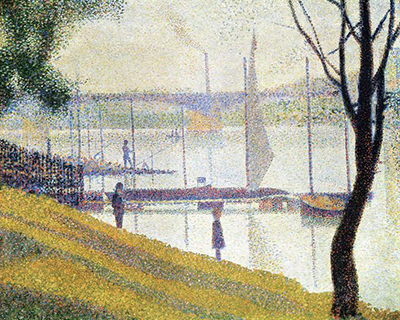The Bridge at Courbevoie is an oil on canvas painting done by Georges Seurat in between the year 1886 and 1887. The painting measures 18.3” by 21.8” in size. The style of painting used by Seurat in this piece combines both pointillism and divisionism techniques that he had come up with. This incredible piece of art is in an exhibition in London, at The Courtauld Gallery.
About the Painting
Seurat created this piece of artwork with a view of River Seine, which is situated in Courbevoie’s industrial region. The views of River Seine can be seen from the La Grand Jatte, an island in the southern part of Paris. Seurat has many paintings that have themes based on the Grande Jatte, but this painting is quite different from the rest. The mood depicted by this painting evokes a sad and quite kind of feeling.
The Bridge at Courbevoie is dominated by three human beings, the smoky chimney, and poles in the water, the boat, green grass, the fence, the water reflections and the bridge.
Right at the riverbank three men who seem socially distanced can be seen, adding further to the dull mood of the painting. The men seem detached from each other and deep in individual thoughts. The feeling of tranquillity is projected powerfully. On the left, there is a boat, seemingly with two people in it. The boat and its occupants cannot be seen through because of the distance.
In the middle, there is a present-day bridge cutting through. Behind it, there is a billowing chimney smoke into the air. These images signify the adverse effects industrialisation has brought on the environment that was formerly calm and unpolluted. They also show how disappointed and affected Seurat is with the developments.
On the right side, there is a black tree with no leaves. In the opposite direction on the foreground, there is a tree with full branches and healthy green leaves. Most probably, the differences symbolise the passing of different seasons.
In this painting, Seurat has used minimal colour strokes. They are visible in the foreground, in the sky and the area covered with grass. Many coloured dots make the finishing achieve a matt look. The dots are more distinct in the reflections from the water. The reflections of the water show distinct dots in more varying colours.
The contrasting colours in the artwork are essential in showing emphasis and the integration brought about by combining colours across the oil canvas. From a glance, the dominating green, grey and purple colours can be seen. This technique of divisionism has increased the general texture and depth of the painting.
The entire picture depicts calmness. There is barely any activity or taking place in the painting. The colours used are also neutral and well balanced, to bring out the much needed inner peace and serenity.




